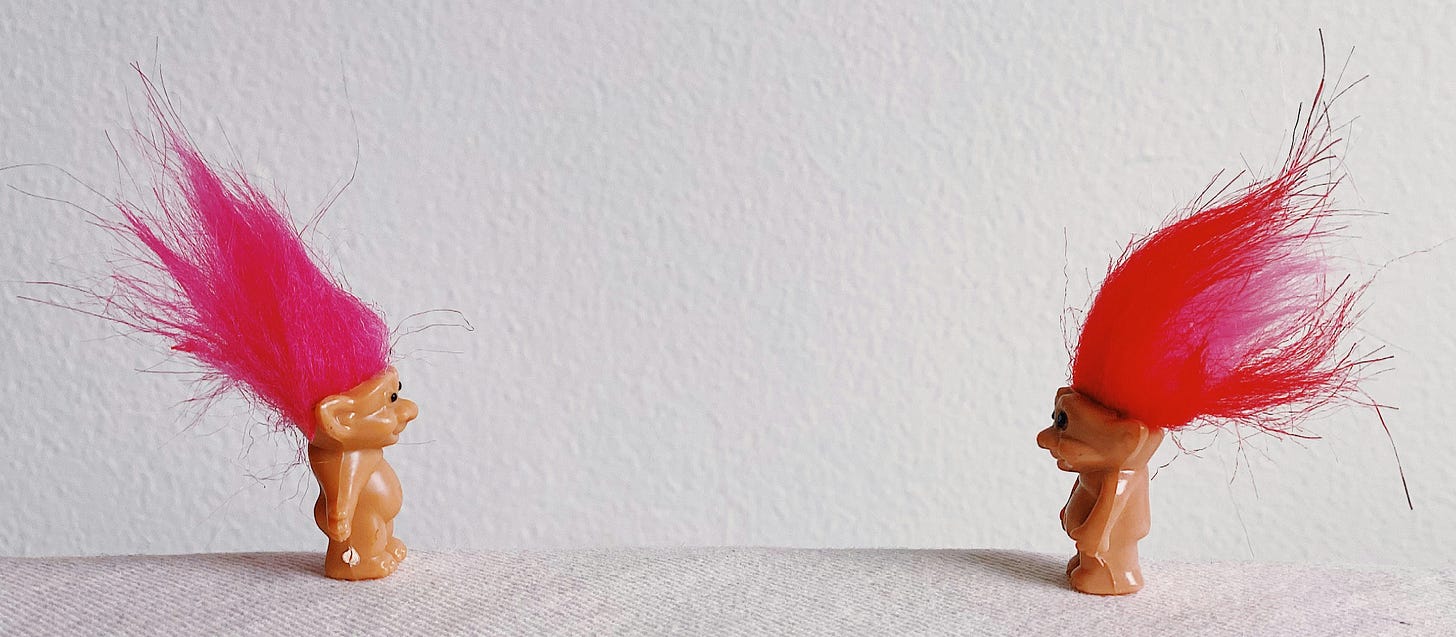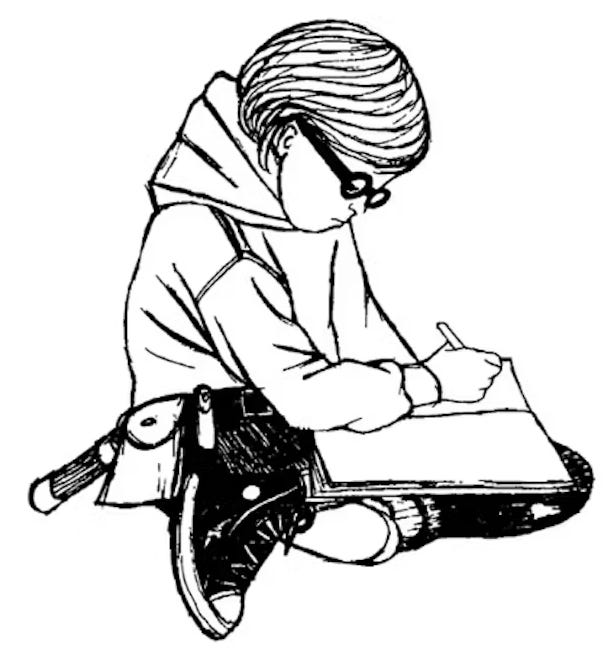Imagining Grace
My very new best friend
I was waiting for Aunt Lily to arrive for a visit, and I paced back and forth walking the path from our living room to the front door and back again in the two-bedroom apartment we lived in on Manhattan’s upper East Side.
I loved Aunt Lily the most of all my aunts. She was my grandmother Meme’s oldest sibling, so she was my GREAT aunt. She was silly and fun, and she knew I loved books and art supplies and kept me well-stocked. She didn’t treat me like a little girl, she was interested in me and asked serious questions about my life and school and friends. I loved it when she’d come to visit. “Where is she,” I thought to myself. Time moved so slowly, and it didn’t help that I couldn’t read a clock yet. I kept asking my mom, more than a couple of times, until she said, “she’ll get here when she gets here, maybe the subway is running late.”
Then, at last, the doorbell rang, with a quick sharp ding followed by a dull-sounding thud.
At the sound of the bell, I ran to the door, and grabbed the doorknob with both hands, pulling as hard as I could––it was heavy for me––but it swung open with a tremendous whoosh and yes! It was Aunt Lily. She stood in the hallway, smiling her big smile. Standing right next to her was a life-sized, Nan-sized doll. The doll was exactly my height. I screamed and slammed the door shut. I hated dolls. Why did she have a doll with her? She knew I hated them, didn’t she? I thought dolls were creepy and scary.
Mom came running, re-opened the door, and Lily stood there out in the hallway, looking confused, but still grinning. She came in––with the doll. She leaned down to me to ask why I slammed the door, and I explained it very matter-of-factly, and not apologetically, and we laughed, and all was forgiven. She apologized to me, admitting that she did forget that I didn’t like them. Lily returned the doll to the toy store and that was the end of that. No more dolls. She still brought me books and art things.
Even though I hated dolls, I did have a Raggedy Ann. She was okay. I tolerated her because she didn’t look like a real person. I had a couple of those Troll dolls, too. They didn’t look like people, and I didn’t understand what I was supposed to do with them. I watched some of my friends act out troll stories, and dress them up in different outfits, giving their already weird hair even weirder hairdos, and I’d just stand there, puzzled and bored out of my mind. The real-looking dolls bothered me the most. Barbies were not my bag. Ever.
And baby dolls? They were made of hard plastic and rubber, and their limbs didn’t bend. If you put one down on its back, their eyelids would shut, only to reopen when placed in an upright position, wearing a dead stare on its equally dead face. I didn’t need a doll. I had a baby brother to play with. He was real! He was cute and smooshy and had soft skin and smelled really good––well, most of the time. I guess not every little kid was as lucky as I was.
I was just no good at make-believe. Even as a child I was a staunch realist who valued facts over fantasy. I completely lacked the ability to pretend. I would try to come up with made-up stories, like my hero Harriet the Spy did when she played “Town” with her best friend, Sport. She could look at a web of tree roots poking out of the ground and see a whole town and imagine the houses and the people who lived in them and invent story lines about the lives of Mr. Hanley who owns the gas station and Ole Farmer Dodge who has no teeth and can only eat oatmeal and how they get robbed by the gangsters who arrive in Town in a long black car, guns a-blazing. Sport couldn’t see any of it either. We just saw the roots and the dirt.
I didn’t believe in Santa Claus––partly because I’m Jewish, I did try––I didn’t believe in the Tooth Fairy. I knew the Tooth Fairy was my mom and dad. I loved the money that I got when I lost a tooth. That was REAL. Whenever I had a loose tooth, I’d sit up late at night in my bed, jiggling it to force it out of its socket before it was ready, so I could cash in. I lived a reality-based life. I didn’t believe in magic carpets even though it would be really cool to have one.
I did love story books when I was a little girl. I knew that Max from Where the Wild Things Are was made up, make believe. I understood that and accepted it. Maybe the distance of a drawing on a page helped. I had no interest in owning or playing with a Max doll. Let him stay in between the covers of the book. That was his home. And the same for Horton and The Whos who lived in Whoville and the Cat in the Hat and Stuart Little and Wilbur and Charlotte. They were so different, so outrageous, that I was able to suspend my disbelief and get lost in their worlds while all the time knowing that I’d never be able to hang out with them in real life, even though I longed to meet Harriet with all my heart.
I tried to imagine superheroes being real. I was always disappointed. No one shows up to save the day.
And now, I’m in my 60s and I’m being asked to suspend my disbelief again. To accept that there may be a power greater than myself. Some call it God, some Allah, some Krishna or Ganesha, or Durga, or Shiva, and on and on. The idea of God has been, for most of my life, something I laughed at. I’d make fun of people who did believe. Not to their faces, but my judgy little brain scorned them for their ignorance and naivete. I couldn’t wrap my head around the idea that something “existed” that I couldn’t see, explain, touch, or understand with my rational mind. That to access it, I’d need to be willing to come to a belief that it exists, and to believe it without measurable evidence. It required faith. I wasn’t sure I knew what that was. It all just felt like make-believe to me.
In 12-Step, we talk about surrendering to God as we understand god. That could mean a higher power, or for the atheists and agnostics in the room, it could mean a higher purpose. So, there was an accommodation for my skepticism. A loophole. I could use serving a higher purpose, like my group, as an alternative to believing in something I just couldn’t imagine believing in. That was my answer to this quandary, at least in the beginning. But as time passed, I listened to people with more experience in recovery, who did possess that elusive thing called faith. And I wanted it.
My sponsor is a woman who believes deeply in God. That’s one of the reasons I wanted to work with her. My curiosity had gotten the better of me, and I want to recover. I shifted into teachable mode, and still found it frustrating, trying to connect with something beyond my comprehension. My sponsor advised me to start practicing by acting “as if.” As if higher power exists, as if I believe. To treat it as a given. That was a stretch for me, but I was game.
I needed to create a baseline for myself. A starting point. I’m very clear that God is not a “he/him” for me. The “God our Father” image, is more than I could ever bear. I thought about the things that appealed to me about finding faith. I wanted something I could latch onto, like an anchor. The name I came up with for my higher power is Grace. I want to be in a state of grace. Calm, unperturbed, and balanced. Rooted in the earth and connected to the sky.
I’m realizing the more I act “as if,” the more time I spend with Grace. I started to realize that Grace resides within me, not outside of me. That she’s been there all along. I had only to open to faith, to possibility, to know that I have the capacity to live a balanced life, and when I’m unsure of where to go, or what to do, I can pause and inquire of Grace. And then I stop and listen. Sometimes the answers don’t come on my timeline, but they do come. Grace is here to teach me that I don’t have to bear my burdens alone. That the answers can be found within. Grace asks me to trust myself.
When I was a child, I was lonely. I didn’t have many friends. I envied the kids who created imaginary playmates––I couldn’t do that––I tried. Reality wouldn’t let me.
So, I’ve been practicing. I’m flirting with Grace. Or the idea of her. At bedtime, I talk to her. I wish her well and thank her for the day. I share my gratitude with her. I feel self-conscious doing it, but I’m doing it anyway. And I feel better for it, more grounded, more clear. This practice reminds me to stay present. I noticed that I’ve also started checking in with Grace throughout my day.
Last week, I was challenged by a person who’s always hard for me to deal with. I knew I was going to see her, and I was anxious; afraid that I would snap at her. Before I saw her, I said out loud, “help me, Grace. Help me to be patient and kind.” I needed to take that pause.
That day, I realized that Grace IS my new imaginary-not so imaginary friend. She’s with me all the time, if I choose to invite her in and embrace her and be embraced. A reminder that I don’t have to have all the answers. A reminder that I am indeed not alone.
It would be swell if you’d become a paid subscriber and support my writing! Or, you can chip in because Harriet needs a new notebook!
AND….I’ll be teaching a 5 Week Zoom Master Class in May all about the ins and outs of publishing on Substack: So, You Want to Write on Substack But You Don’t Know Where to Start? Find out more or register now!








My earliest association with the word “grace” was the prayer that we recited at the table before dinner. You could not eat before saying grace. It was a nice little ritual. The concept of grace (God’s forgiveness as something granted, not earned) was a cornerstone of the faith in which I was raised. Amazing Grace. It’s a lovely name to bestow on your guiding spirit. Thanks for this tender tribute to the young Nan. xoxo
Fellow Harriet the Spy fan with Raggedy Ann as the tolerable doll. 🙋🏻♀️ I had no idea we had so much in common. This is beautifully, truthfully written. Hello, Grace.